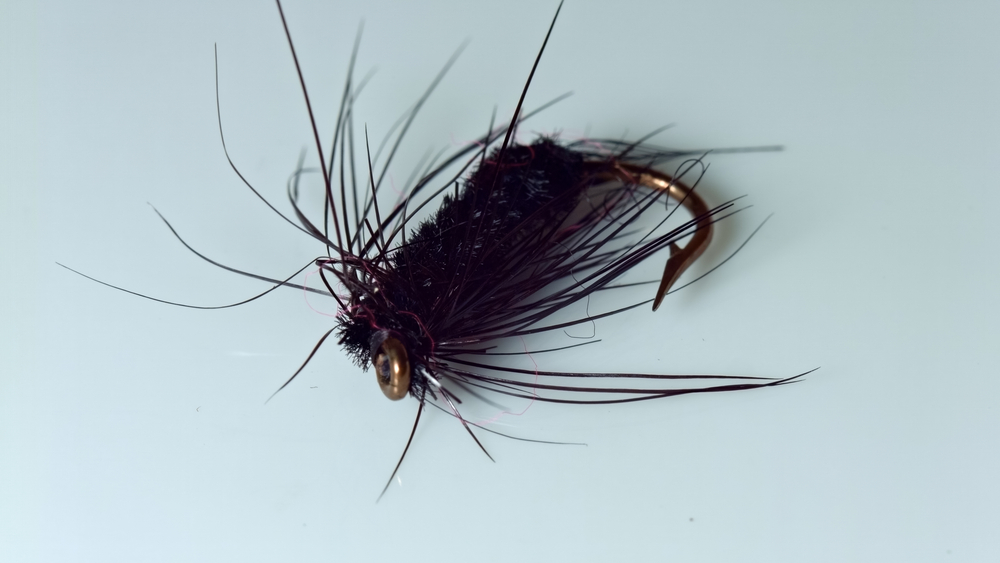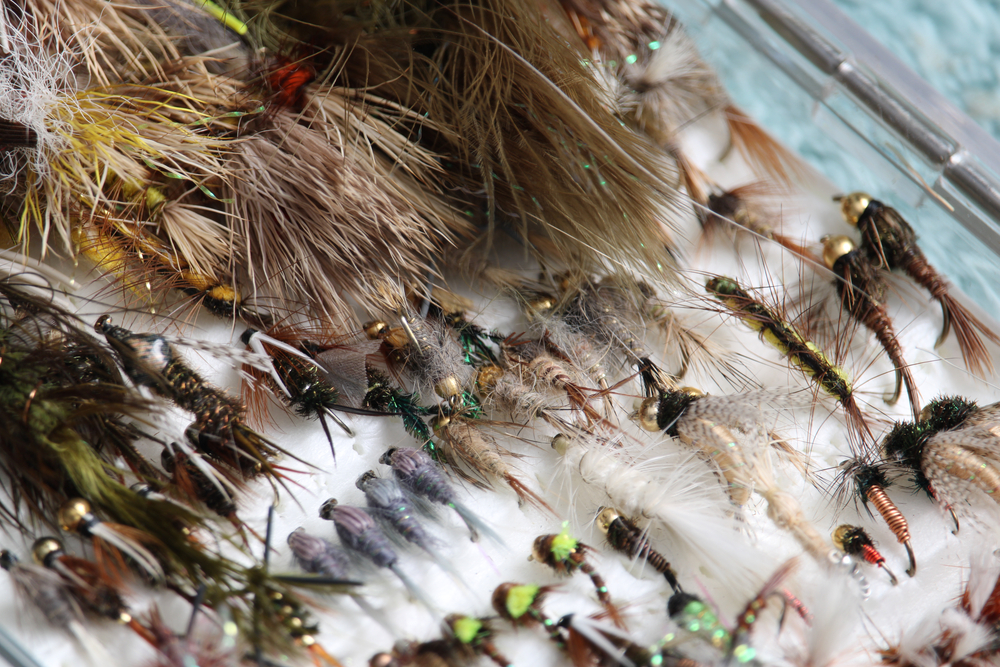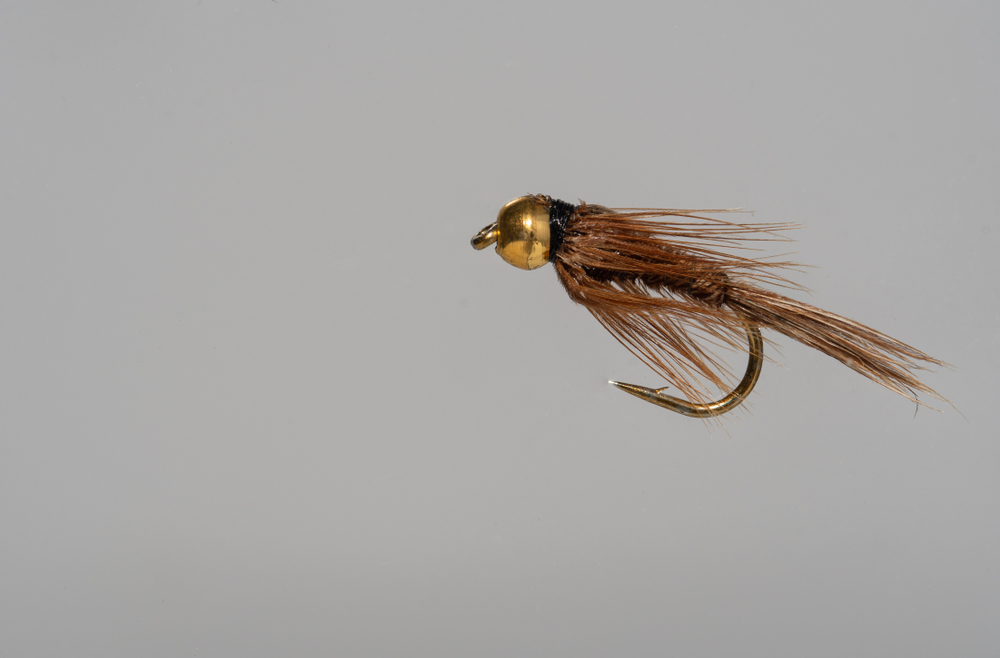The mop fly is often the most overlooked fly in a fisherman’s box. But, it can be an easy way to catch more fish if you know how to use it. It’s easy to go wild at the fly shop, getting a few flies of every pattern so that you’re always covered if the trout decide to be fussy on any given fishing day. But, it’s often the classics that have worked for years which we anglers seem to forget to load up on. So what is a mop fly and how do you use one? Let me show you! First off, let me explain why some people might not want this particular type of fly- and then I’ll tell you why.

What is a mop fly?
A mop fly is a type of fly that imitates insect larvae, worms, or grubs usually found near or in damp land surrounding rivers and lakes. The most common types are tied with tungsten beads to make them heavier and more durable. Mops can be green, cream, white, and even yellow. Some are tied with dubbing at the bead while others use hackles (usually brown). They range from an inch long to two inches long.
Mop flies imitate insects that trout find attractive such as mayflies (the adults), stoneflies (nymphs), caddisflies (larvae), black soldier flies, crane flies (larvae), dragonfly nymphs, damselflies nymphs
When should you fish the mop fly?
To catch fish, a fly fisher needs to think about when certain food sources like worms and grubs enter the river they’re fishing on. Grubs are usually found in dirt around rivers so during high water periods these will get washed into the system where it becomes part of an aquatic ecosystem’s food chain which is how fishermen find them by looking for different patterns of activity or indicators that this type of worm has been eaten recently. The best time to start using mop flies as bait would be from spring until summer because things often hatch at those times with rain and flooding being common causes while you should switch back over near fall once everything starts settling down again after winter weather arrives.
Mop flies are one of the most effective patterns in fly fishing for smallmouth bass. The season is open year-round, but they provide a bigger payoff after rain or snowmelt when river levels are high and visibility diminishes due to more sediment on top of water layers.
In addition to trout and salmon, mop flies can be used with great success at any time during the year for catching those pesky little browns that live amongst rocks near shorelines where it’s difficult to cast larger lures such as spoons because their range varies from very close up through 30 feet out then back again which makes them hard targets even though you’re fishing directly over their heads!
What fish can you catch with a mop fly?
-Mops are mostly fished to catch trout but they will work for bass and panfish like crappies too.
-Pretty much any fish in a river system will feed off grubs, but since trout are quite aggressive fish and are fished for more than any other species on the fly, they tend to be caught on mops the most.

How do you fish mop flies?
Mops can be fished in the same way as nymphs. They are either a different form of them or, depending on who you ask, they might not even exist at all! Regardless if it is true or not that mops and nymphs share similarities, one thing for sure is how to fish with both: upstream using slow water sources like pocket pools when casting from the surface; let fly drift freely until taken by trout.
You want your mop fly to bounce along the bottom and you should adjust your rig depending on how deep, shallow, fast or slow the water is. We’ll cover more detail later about rigs but for now a handy point to note if you’re fishing in creeks, tailwaters or large rivers is that it’s best near places around banks where grubs come from so this will be where rainbow trout and brown trout are most likely going to position themselves ready for an easy meal.
How to rig a mop fly for different situations
To catch fish, rig a mop fly by first tying on some weight forward floating line. Next tie 3ft of 4x or 5x fluorocarbon tippet to your leader using the Tippet Ring Knot for easy removal. Finally attach one end of this tippet with either an overhand knot, blood loop knot, or Albright knot and then place the other end around a piece of old coffee filter paper that is wetted down so it’s more pliable like yarn hair in dollhouses before you wrap it tightly together To rig a mop fly, start off with a generic nymph rig on weight-forward floating line. You’ll want about 9 ft of 3/4x or 8/6lb leader and then tie it onto your tippet end using either 4x fluorocarbon or 5x dacron material with the help of either an appropriate knot (e.g., Albright) or ring made from lighter gauge wire in order to hold everything together securely for fishy bites!
Adjusting for depth
Fishing deep water can be tricky, so make sure you have enough weight on your mop fly to get it down there. Make the chartreuse indicator adjustable because if it is too close to the bottom of the stream or river, then your mop fly might not work correctly and become caught up in weeds at its base.

Adjusting for current
The fly fishing techniques differ depending on the water, and you’ll need to adjust your rig accordingly. When running into slower flows with more time for an insect imitation to sink before it reaches a fish’s feeding zone, less weight is needed in order get that mop fly or other pattern down where they want it – this also means there will be more chances at getting hit by curious trout taking their time inspecting what just landed!
This is where a spinning reel for bass can come in very handy. It can let you adjust things on the fly and always be perfect calibrated for any current.
When the river is moving at a fast pace, it can be difficult to get your flies down in time if you’re using lighter tippets and mop flys. To combat this problem, fishing heavier patterns or adding split shots are both good options. You could also fish with high-quality fluorocarbon tippet as these will sink quicker than traditional rope silk lines due to their low density of material for sinking purposes
Getting your drift right
One of the things you have to be careful about when fishing upstream with a mop is getting your drift right. You want it so that by the time any fish see your fly, they’re too busy looking at themselves in what can only be described as an angelic soul-catching net and won’t notice anything else for quite some time.
To catch more fish, cast your line at a 45 degree angle and avoid casting it straight up the river. If you do this while mending or making adjustments to your rig on its way downriver, the fish will have less of an opportunity to see what’s going on below them.
The retrieve & hook up
The mop is tied in a way that the current gives it enough action for fish to either eat them aggressively or sip them subtly, hence the need for an indicator. Keep stripping as you feel your presentation coming closer and towards you without disturbing drift when there are any signs of bobbing down on your line. Lift up quickly once contact has been made with what should be a hooked fish!

Conclusion
Fly fishing is a great hobby that can be done in the outdoors. Fly mops are an essential piece of equipment for fly fishers and they come with benefits to make your experience better. These include: -You don’t have to worry about hooks getting snagged on weeds, branches or rocks because you’re using artificial flies instead of bait so it’s easier to catch fish without being tangled up in anything! With higher quality lines like fluorocross which sinks quickly, you’ll also need less weight at the end of your line than when fishing traditionally. The design allows for more natural presentation as well since these types of flies imitate insects found naturally underwater rather than those used by traditional anglers who often use lures or baits which may not be as realistic.
Fishing with a fly mop is also great for beginners because it’s easier to see what you’re doing and the flies can sink more easily, which means less weight will need to be added in order to get your fly down there where fish are feeding! The wide variety of colors available including chartreuse makes them easy to spot from afar or when they land on either side of the river so you don’t have any trouble getting back up after making adjustments if needed. You’ll never lose sight of your line again thanks to this indicator that tells you exactly how deep below water level your rig is – hence why we recommend fishing at a 45 degree angle and avoid casting straight upstream in deeper waters! This way, fish will have less of a chance to see what’s happening below them.






